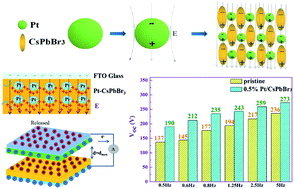Bulk Pt/CsPbBr3 Schottky junctions for charge boosting in robust triboelectric nanogenerators†
Abstract
Triboelectric nanogenerators (TENGs) have attracted growing attention because they are advanced energy conversion devices to efficiently harvest low-frequency mechanical energy from nature. How to increase the permittivity of electrode materials as well as the surface charge density is technically important to improve the output performances of a robust TENG. In this study, an all-inorganic cesium lead bromide (CsPbBr3) perovskite film with semiconducting characteristics is combined with metallic nano-platinum to build bulk Pt/CsPbBr3 Schottky junctions, which are used as triboelectric electrode materials in vertical contact-separation perovskite TENGs. The systematic characterization demonstrates that the electron binding energy and dielectric properties of bulk Pt/CsPbBr3 Schottky junction tailored perovskite films are maximized by optimizing the Pt dosage. An open-circuit voltage of 273 V, a short-circuit current density of 30.3 μA cm−2 and an instantaneous maximum power density of 1295.5 mW m−2 are achieved by the champion Pt/CsPbBr3 TENG at a Pt dosage of 0.5%. A maximum energy storage of 3.96 mJ is stored in a 1 μF capacitor within a 300 s charging period. This work provides new insights into Schottky junction TENGs for enriching the fundamental principles of both halide perovskites and TENGs.

- This article is part of the themed collection: Journal of Materials Chemistry A HOT Papers


 Please wait while we load your content...
Please wait while we load your content...